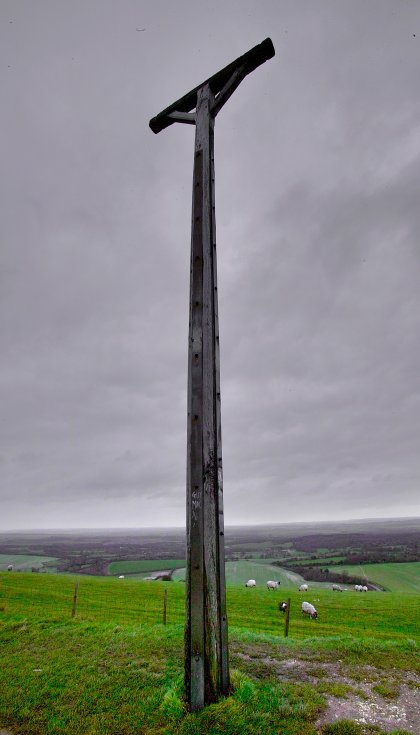On this date in 1676, the Combe Gibbet was put to its first and only use.
Adulterous lovers George Bromham (or Broomham) and Dorothy Newman had been doomed by the Winchester Assize for murdering the wife and son of Bromham’s inconvenient marriage. “With a staff,” the trial record says. Ouch.
The two were sentenced to hang together “in chaynes near the place of the murder,” which demonstrative sentence required the erection of a brand-new purpose-built double gibbet just for the occasion, high atop Inkpen Beacon, the 975-foot hill overlooking the countryside.* After execution, they were taken down, laid out a nearby barn (inevitably to become known as “Gibbet Barn”), and then strapped back up on the double-gallows in chains for a few days.
Although this dreadful landmark has never been used again, it’s stood ever since. Or, technically, a succession of different versions have stood, but the point is that there’s still today a large, black execution device looming over scenic Berkshire. It’s a nice place for a walk. (pdf)
When next in West Berkshire, top your visit to the Combe Gibbet with a refreshing Gibbet Ale at Inkpen Common’s Crown and Garter Bed & Breakfast. (That’s where the Gibbet Barn used to be.)

The murder behind the gibbet was the the subject of a student film called Black Legend in 1948 — the first movie made by future legendary director John Schlesinger.
* Bromham was from Combe, and Newman from neighboring Inkpen, and the murder itself took place on the towns’ border. In the great tradition of municipal politics, there was a consequent dispute over the bill for setting up this gibbet; they were forced to split the bill.
On this day..
- 1944: Osmund Brønnum
- 1562: Sophie Harmansdochter, "Gele Fye"
- 1882: Dead Shot, Dandy Jim and Skippy, mutinous Apache scouts
- Themed Set: The Ordinary of Newgate
- 1708: Thomas Ellis and Mary Goddard
- 1903: Edgar Edwards, sash weight killer
- 1882: Bob Jones and Billy Miller, murderers on the open road
- 1522: Vicent Peris, of the Revolt of the Brotherhood
- 1865: Antone Richers, Galveston deserter
- Unspecified Year: Bigger Thomas
- 1955: Gerald Albert Gallego, like father like son
- 1323: Andrew Harclay, too chummy with the Scots
- 1999: Walter LaGrand, a German gassed in America


Didn’t he kill his wife by putting her head in a hornet’s nest?